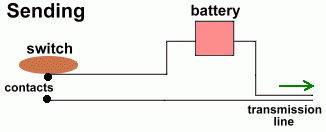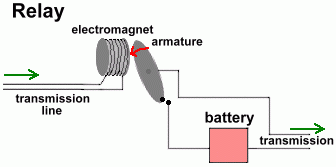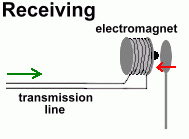|
Morse code was an alphabet devised by the American inventor Samuel Morse for use in telegraph systems. It has also been used by ships to transmit messages using lamps, and by radio operators all over the world. Originally, telegraph messages were meant to be sent over wires, allowing the first means of instant communication between people in different places. Although Morse was a painter and sculptor, he became interested in chemical and electrical experiments, and developed an apparatus for an electromagnetic telegraph that he completed in 1836. He also invented a code, now known as the Morse code, for use with his telegraph instrument. International Morse Code consists of combinations of dots and dashes representing the letters of the alphabet and numbers; the duration of one dash equals that of three dots. In 1843 the U.S. Congress gave Morse $30,000 to construct an experimental telegraph line between Washington, D.C., and Baltimore, Maryland. The line was successfully installed, and on May 24, 1844, Morse sent the first message: "What hath God wrought!". Morse's original device can be seen above.  Original Morse code devices were simple switches that closed a circuit when a button was pushed. Connected to a battery, the lever was struck once with a finger and released; this action momentarily completed a circuit, which sent an electrical pulse through a transmission wire. Morse quickly discovered that an electrical signal sent through wires in this way would soon grow too weak to be received. Beyond a distance of about 32 kilometres, the signal disappeared because of the friction (resistance) in the copper transmission wires. Morse invented a relay device to boost the signal.  Relay switches were attached to the transmission line about every 30 kilometres. The incoming signal was just strong enough to activate an electromagnet, which caused an armature to rotate. The armature closed a new circuit, connected to a battery, which caused a new, fresh signal to be sent out. The original signal, as it moved down the transmission wires, was re-sent over and over, every time it reached a relay. In this way, it could be transmitted thousands of kilometres.  When the signal reached its destination, it caused an electromagnet to become active with each pulse. As it did, it attracted a metal 'clapper', which struck a plate attached to the magnet, making a distinctive noise. Longer signals made longer noises, so the original operator could cause the receiver to emit short or long 'clicks' by tapping out short or long signals on the originating device. Operators on either end quickly learned to translate short and long clicks ('dots and dashes') into regular text, making sending and receiving a simple operation. International Morse code today is most popular among amateur radio operators. Warships, including those of the U.S. Navy, have long used signal lamps to exchange messages in Morse code, as a way to communicate while maintaining radio silence. An important application is signalling for help through SOS; this can be sent many ways: keying a radio on and off, flashing a mirror, toggling a flashlight, and similar methods. Hear the morse code for SOS here. Morse code has also been employed as an assistive technology, helping people with a variety of disabilities to communicate In some cases, this means alternately blowing into and sucking on a plastic tube (a 'sip-and-puff' interface). Once learned, it does not require looking at a display. The text box below will allow you to enter any word or sentence (using letters and numbers - no punctuation) in English, and will show you the Morse code equivalent. You can also copy the code produced, with the translation, and paste it into a text editor. |